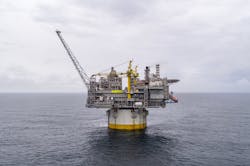Offshore staff
STAVANGER, Norway – Production has started from the Aasta Hansteen gas field in the Norwegian Sea, with exports also flowing for the first time through the new Polarled pipeline to Nyhamna, western Norway.
The development, in 1,300 m (4,265 ft) of water, this is the deepest offshore Norway to date, and involved construction of the country’s first spar platform which is also the world’s largest, according to operator Equinor. It is 339 m (1,112 ft) tall and weighs 70,000 metric tons (77,162 tons), and the tow to the field this April was the largest-such operation on the Norwegian shelf since Troll A in 1995.
Gas is produced from seven wells connected to three subsea templates, and the platform and the 482-km (299-mi) Polarled both have the capacity to accommodate new discoveries in the area. One of these, Snefrid North, is already under development, and will come onstream toward the end of 2019.
Equinor estimates recoverable resources atAasta Hansteen, including Snefrid North, at 55.6 bcm of gas and 0.6 MMcm of condensate.
“The production from theAasta Hansteen field will help secure long-term Norwegian gas export,” said Arne Sigve Nylund, executive vice president for Development and Production Norway. “With the infrastructure installed it will also be more attractive to explore around the platform and along the pipeline. This enables us to secure activity for many decades, in line with our ambitions for the NCS.”
The subsea templates were built in Sandnessjøen and the suction anchors for the platform in Mo i Rana, Norway. The platform was hooked up at Stord south of Bergen.
Operations will be managed from Harstad, with base services delivered from Sandnessjøen and helicopter services from Brønnøysund.
Equinor estimated the overall project cost at around NOK37.5 billion ($4.35 billion) in 2018 terms, NOK2.9 billion ($337 million) higher than the figure cited in the original development plan. The increase is said to be due to weak kroner.
Polarled, the first offshore pipeline to cross the Arctic Circle, terminates at the Nyhamna plant where the rich gas undergoes processing, with dry gas forwarded to the UK and continental Europe through Norway’s integrated transport system.
To accommodate supplies from Aasta Hansteen and future discoveries in the Norwegian Sea, the plant has been converted and expanded.
The pipeline is 36-in. in diameter, with a transport capacity of around 70 MMcm/d.
12/17/2018



